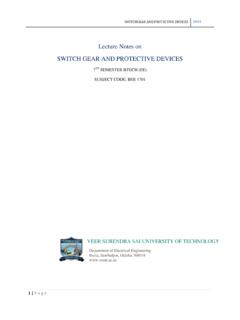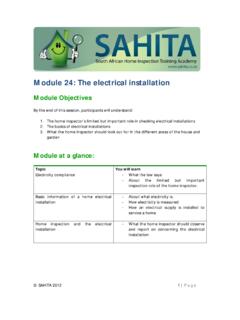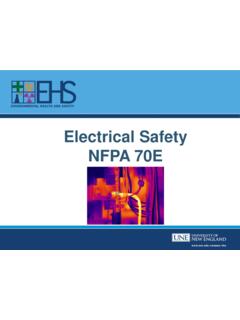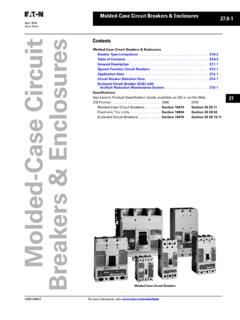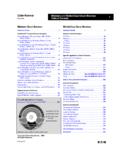Transcription of CHAPTER-7 circuit breaker. - IIT Roorkee
1 367 CHAPTER-7 HIGH VOLTAGE circuit breaker Introduction circuit breaker is a mechanical switching device capable of making, carrying and breaking current under normal circuit condition as well as under specified abnormal circuit condition such as short circuit etc. circuit breakers are generally classified according to interrupting medium used to cool and elongate electrical arc permitting interruption. Selection of outdoor circuit breakers for switchyards 12 kV and above (highest system voltage) as regards types, rating, performance requirements and tests for AC high voltage circuit breakers that are installed in hydro power stations outdoor switchyards after the step up transformer on outgoing transmission line feeders are discussed. Special requirement for rating of AC high voltage generator circuit breakers between the generator and transformer terminals are also discussed.
2 Standards Relevant National and important international standard in this connection are as follows: 1. IS: 13118/ - Specification for high-voltage alternating current circuit IEC56 breakers 2. IEC: 62271 - High voltage alternating current circuit breakers 3. IEEE: 37010 - IEEE Application Guide for AC high voltage circuit breakers 4. IEEE 37013 - AC high voltage generator circuit breaker rated on symmetrical current basis Note: IEC 56 was withdrawn in 2001 and replaced by IEC 62271-100 Type of HV circuit Breakers Following types of circuit breakers formerly used in high voltage outdoor substations are no longer in use and are being phased out. i) Bulk oil circuit breakers (Dead Tank Design) In these circuit breakers oil content is used for arc extinction and also for insulating live parts from the tank which is dead and generally earthed (grounded).
3 Ii) Minimum oil breakers (Live Tank Design) In these circuit breakers oil is primarily used for arc extinction and not necessarily for insulating live parts from earth (ground). The tank of these circuit breakers is insulated from earth ground. The circuit breakers are phase separated. These circuit breakers were widely used up to 72 kV level and are being phased out from existing installation. iii) Air blast circuit breaker circuit breaking in these circuit breakers occurs in a blast of air under pressure. These circuit breakers were widely used up to 765 kV system. These circuit breakers are also being phased out. Following types of circuit breakers (for max. voltage class) are in use now-a-days in hydro plants step up substations. i) SF-6 Sulphur Hexa Flouride Breakers 36 kV to 765 kV class ii) Vacuum circuit breakers up to 36 kV class iii) Air circuit breaker up to 12 kV Sulphar Hexafluoride as an Arc Quenching Agent Pure sulphar hexafluoride gas is inert and thermally stable.
4 It possesses very good arc quenching as well as insulating properties which make it ideally suitable for use in a circuit breaker . Sulphar hexafluoride remains in a gaseous state up to a temperature of 90C at 15 kg/cm2 pressure. Its density is about five times 368 of air and the free heat convection is times as much as that of air. Apart from being a gas, it is non-inflammable, non-poisonous and odourless. When arcing takes place through the gas, some by-products are produced due to breakdown of the gas. These by-products are a hazard to the health of the maintenance personnel therefore should be properly taken care of. At a pressure of three atmospheres the dielectric strength of sulphar hexafluoride is about times that of air and compares very well with that of oil. Even when gas is exposed to electric arcs for fairly long periods, it has been found that decomposition effects are small and the dielectric strength is not materially affected.
5 On the other hand the metallic fluorides at the temperatures of the arc are good insulators and the arc is therefore, not at all harmful to the breaker . Gas circuit breakers generally employ SF-6 (sulphar hexafluoride) as an interrupting medium and sometimes as an insulating medium. In single puffer mechanisms, the interrupter is designed to compress the gas during the opening stroke and use the compressed gas as a transfer mechanism to cool the arc and to elongate the arc through a grid (arc chutes), allowing extinguisher of the arc when the current passes through zero. In other designs, the arc heats the SF6 gas and the resulting pressure is used for elongating and interrupting the arc. Some older low-pressure SF6 breakers employed a pump to provide the high pressure SF6 gas for arc interruption. Gas circuit breakers typically operate at pressures between six and seven atmospheres.
6 The dielectric strength of SF6 gas reduces significantly at lower pressures, normally as a result of lower ambient temperatures. Monitoring of the density of the SF6 gas is critical and some designs will block operation of the circuit breaker in the event of low gas density. circuit breakers are available as live-tank or dead-tank designs. Dead tank designs put the interrupter in a grounded metal enclosure. Interrupter maintenance is at ground level and seismic withstand is improved versus the live-tank designs. Bushings are used for line and load connections which permit installation of bushing current transformers for relaying. The dead-tank breaker does require additional insulating gas to provide the insulation between the interrupter and the grounded tank enclosure. Live-tank circuit breakers consist of an interrupter that is mounted on insulators and is at line potential.
7 This approach allows a modular design as interrupters can be connected in series to operate at higher voltage levels. Operation of the contacts is usually through an insulated operating rod or rotation of a porcelain insulator assembly by an operator at ground level. This design minimizes the quantity of gas used for interrupting the arc as no additional quantity is required for insulation of a dead-tank enclosure. The design also readily adapts to the addition of pre-insertion resistors or grading capacitors when they are required. Seismic capability requires special consideration due to the high center of gravity of the interrupting chamber assembly. Interrupting times are usually quoted in cycles and are defined as the maximum possible delay between energizing the trip circuit at rated control voltage and the interruption of the main contacts in all poles.
8 This applies to all currents from 25 to 100% of the rated short circuit current. breaker ratings need to be checked for some specific application. Applications requiring reclosing operation should be reviewed to be sure that the duty cycle of the circuit breaker is not being exceeded. Some applications for out of- phase switching or back-to-back switching of capacitor banks also require review and may require specific duty circuit breakers to insure proper operation of the circuit breaker during fault interruption. Vacuum circuit breaker Vacuum circuit breakers use an interrupter that is a small cylinder enclosing the moving contacts under a high vacuum. When the contacts part, at the first current zero, dielectric strength across the contacts builds up at a very much higher rate than that obtained with conventional circuit breakers.
9 High vacuum gap recovers most of its dielectric strength within 10 micro seconds. The arc products are immediately forced to and deposited on a metallic shield surrounding the contacts. Without anything to sustain the arc, it is quickly extinguished. It is almost maintenance free switchgear. 369 Vacuum circuit breakers are widely employed for metal-clad switchgear up to 36 kV class. The small size of the breaker allows significant savings in space and material compared to earlier designs employing air magnetic technology. When used in out door circuit breaker designs, the vacuum cylinder is housed in a metal cabinet or oil filled tank for dead tank construction. Advantages and Disadvantages Advantages: Advantages of SF6 breakers over the conventional breakers is given below: i) Due to outstanding arc quenching property of SF6, the arcing time is very small.
10 This reduces contact erosion. ii) Using SF6 gas at low pressure and low velocity; the current chopping can be minimized. iii) During arcing of SF6 breaker , no carbon dioxide is formed and hence no reduction of dielectric strength. iv) SF6 breaker is silent in operation and moisture ingression into the gas cycle is almost nil. v) SF6 breaker performance is not affected due to variation in atmospheric conditions. vi) SF6 breaker is compact in size and electrical clearances are drastically reduced. Disadvantages: The only disadvantage of using SF6 to some extent is suffocation. In case of leakage in the breaker tank, this gas, being heavier than air settles in the surroundings and may lead to suffocation of the operating personnel. However, it is non-poisonous. Evaluation of SF6 and Vacuum Switching Technologies SI. No.
